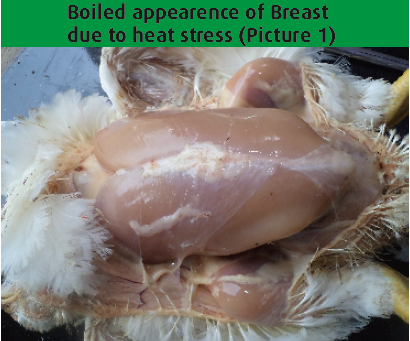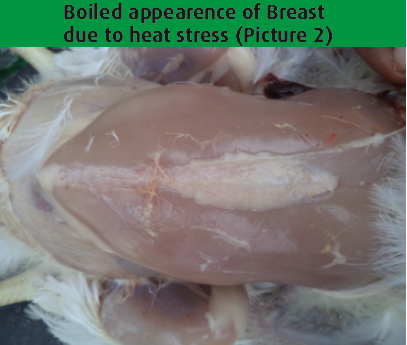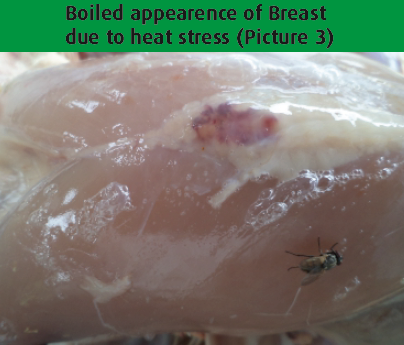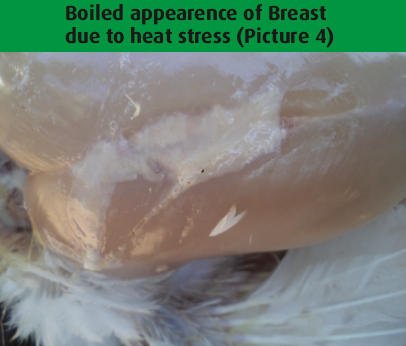Heat stress due to summer has several serious and economical effects on poultry. In broilers it can cause reduced growth rate, decreased feed intake and poor feed conversion. Laying birds experience a drop in egg production, poor egg weight and reduced eggshell quality.
THERMOREGULATION IN POULTRY
The poultry rearing is well managed in temperature between 21-250C which is called as thermo neutral zone; temperature above 350C will cause heat stress to birds causing physiological changes. Chickens, unlike most other animals, do not possess sweat glands to aid in heat loss. Chicken removes excess body heat by following mechanisms.
Radiation- Heat will radiate from the bird’s warmer body to a cooler surface, such as air, without the use of a medium (surface).
C o n d u c t i o n – H e a t stressed birds will try to cool their bodies down by touching water pipes or digging into litter to come into contact with a cool floor.

Convection- Moving air over birds is the most
effective way to reduce heat stress. If the air is not moving quick enough, heat will begin to build up around the birds, which will increase heat stress.
PHYSIOLOGICAL & BEHAVIORAL CHANGES DURING HEAT STRESS
Under high temperature conditions, birds alter their behavior and physiological homeostasis seeking thermoregulation, thereby decreasing body temperature. Following are the important changes which adversely affects the performance.
REDUCED FEED CONSUMPTION
Water intake increases which leads to loose or watery droppings and increased volume of urine causes wet litter condition. This makes the litter environment favorable for the sporulation of coccidian spores.
Decreased blood flow to digestive tract causes immunosuppression, dysbacteriosis results into coccidiosis and necrotic enteritis
HYPERVENTILATION OR PANTING – Evaporation of one gram of water from lungs dissipates 540 calories of maintenance energy due to increased muscle activity, hence it is said that summer feed should have more energy.

Increased panting under heat stress conditions leads to increased carbon dioxide levels and higher blood pH (i.e., alkalosis). It also makes birds more prone to respiratory distress. Because of rapid panting (up to 10 times more than normal) and oxidative stress, degradation of cilia occurs which facilitates lodgment of Mycoplasma. As the heat stress elevates the multiplication of Mycoplasma it further causes respiratory distress, air saculitis. Though Mycoplasma as own doesn’ t cause mortality it results into Immune supppression and occurrence of secondary infection . Some epidemiological studies also suggests that prevalence of viral diseases like IBD, VVND, etc. which causes Immune supppression. This also leads to occurrence of mycoplasmosis and further respiratory diseases.
Increased loss of minerals like sodium, potassium, etc. through panting disturbs the electrolyte balance.
HORMONAL CHANGES DURING HEAT STRESS

High environmental temperatures alter the activity of the neuroendocrine system of poultry and elevate plasma Corticosterone concentrations. Increased Corticosterone concentrations i.e. epinephrine and nor epinephrine causes increase in blood pressure, muscular tone and blood sugar levels. The combined effect results into increased mentainance energy which ultimately reduces the performance of the bird.
EFFECT OF HEAT STRESS ON IMMUNE -RESPONSE
Increased environmental temperature causes Immunosuppression by reducing growth of bursa, GALT and spleen, Circulating antibodies, lymphocytes, phagocytic activity of macrophages, etc.
Immunosuppression jeopardizes the birds into i n f e c t i o n by o p p o r t u n i s t i c p a t h o g e n s l i ke mycoplasmosis, coccidiosis, necrotic enteritis, E.coli, ND, IBD, etc.
CLINICAL SIGNS
Low feed intake Increased water intake Diarrhea or loose droppings Incidence of ascites increases Panting and rapid respiration Poor FCR and lower body weight Reduction in egg production, egg size, egg weight, and poor shell quality.
POST-MORTEM FINDINGS
Dehydrated carcass Cooked breast appearance Mucous exudates in mouth and nostrils Pale or cyanotic comb Par boiled appearance of breast Increased body temperature Fluid contents in intestine Rapid decomposition of carcass.
HEAT STRESS MANAGEMENT
To overcome the huge economic loss by heat stress, control should be based on following steps-

MANAGEMENT ASPECT
- Hang wet gunny bags on the sides.
- Evaporative cooling- S p r i n k l e r s a r e commonly used for evaporative cooling when temperatures are more then 40-41°C.
- S t o c k i n g d e n s i t y – R e d u c i n g t h e b i r d density in summer will give more floor space per bird and allow more heat to escape f rom underneath their bodies and from the litter.
- Ventilation- Proper ventilation is crucial for heat stress management. A good ventilation system removes moisture, brings in an equal amount of fresh outside air, directs incoming air to all areas equally, keeps inside air moving to flush hot, humid air from between the birds, etc.
NUTRITIONAL ASPECT FEEDING PRACTICES
As there is decrease in daily feed intake increase the nutrition density, make the feed more concentrated. If there is enough floor space, extra feeders should be added. Encourage eating at cooler times of the day, i.e., early morning or in the evening. Remove feed 4 to 6 hours prior to an anticipated heat stress period. Birds should not be fed or disturbed during the hottest part of the day. Provide cold water for drinking especially during day times.
ENERGY- In order to provide higher energy levels fat inclusion should be more in feed which increases calorific value, palatability, feed intake by 5% and utilization of nutrients.
PROTEINS- The requirements for protein and amino acids are independent of environmental temperature. Oxidation of protein also elevates the heat stress hence it is good to keep protein level low with balanced amino acids. Hence low protein levels (1-2% lower than usual) with higher critical amino acids i.e. lysine and methionine (5-10% higher than usual) is more helpful in managing heat stress.
MINERALS & VITAMINS
The loss of activity of vitamins during storage at high temperature is prime concern during summer which makes it unavailable for bird. Heat stress also disturbs synthesis of vitamin C and absorption of vitamin A and E. Hence to avoid problems of vitamin deficiency due to above stated reasons 20-30% extra vitamins should be provided to the birds.
Vitamin C-200-500 gm/ton of feed, Vitamin E- 50 gm/ton of feed should be provided.
ELECTROLYTES
0.5-0.6% potassium and 0.5% sodium bicarbonate should be added to neutralize the respiratory alkalosis and its consequences.
MEDICATION
Proper preventive measures to avoid respiratory and gut health problems should be taken during summer as these two systems are getting more involved.
Antimycoplasmal agents (Pharmasin®- Tylosin, Vetmulin® – Tiamulin & Tilmovet® – Tilmicosin) should b e p r o v i d e d w i t h p r o p e r d o s e t o p r e v e n t mycoplasmosis and secondary infection.
Anticoccidial program should be well maintained during the summer. As a managemental practice farmer keeps birds off feed during hot period, this lowers the concentration of anticoccidial and infection may occur. To prevent coccidiosis proper anticoccidial programme with suitable molecule should be adapted.
As heat stress causes dysbacteriosis and increases chances of necrotic enteritis probiotics (B-Act®- B.licheniformis) and feed additives (Albac® – Bacitracin, Flavomycin® – Flavophospholipol, etc.) should be given to birds as a preventive measure.